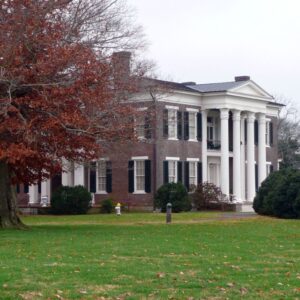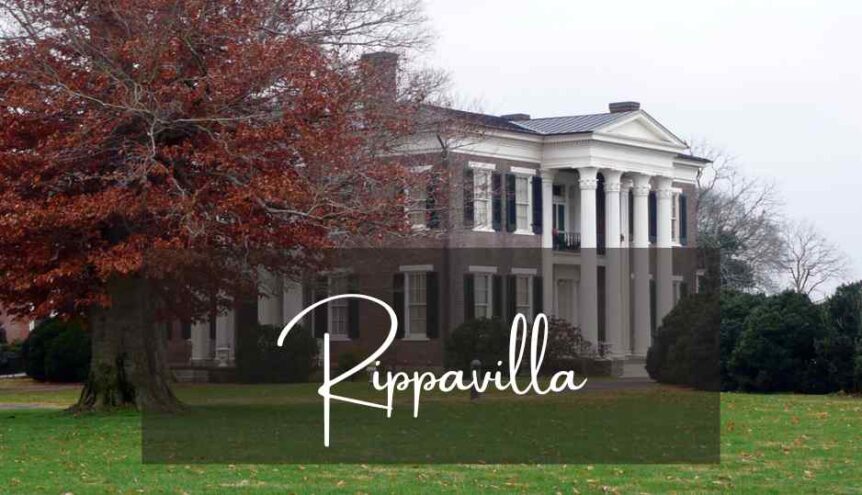 Welcome back. Today’s plantation has an unusual name, and from everything I’ve read, no one is sure how it came about. It’s the Rippavilla, and is located in Spring Hill, which is slightly southwest of Nashville. Built in 1855, this was the home of Nathaniel and Susan Cheairs. Here is a little interesting tidbit—Nathaniel was the youngest of ten children (nine of whom survived), and his father was Nathaniel III. His mother’s name was Sarah, which was also the name of his grandmother. Supposedly, there were five generations of Nathaniels who married women named Sarah—until Nathaniel the IV fell in love with Susan.
Welcome back. Today’s plantation has an unusual name, and from everything I’ve read, no one is sure how it came about. It’s the Rippavilla, and is located in Spring Hill, which is slightly southwest of Nashville. Built in 1855, this was the home of Nathaniel and Susan Cheairs. Here is a little interesting tidbit—Nathaniel was the youngest of ten children (nine of whom survived), and his father was Nathaniel III. His mother’s name was Sarah, which was also the name of his grandmother. Supposedly, there were five generations of Nathaniels who married women named Sarah—until Nathaniel the IV fell in love with Susan.
I read a blog post by author Michelle Stocklee in which she shared that when Nathaniel announced his engagement, his father offered him $5,000 (around $230,000 in today’s economy) to break up with Susan and find a wife named Sarah. They were definitely hung up on the tradition. Kind of makes me wonder if any of them (except for Nathaniel IV) married for love.
I found it interesting that the name Nathaniel, which was so important to pass down to the next generation, was given to the youngest son. Wouldn’t you think Nat’s parents would’ve named their first son Nathaniel? How did they know there would be more? The first two were named Benjamin and James—both died in their 30’s and were buried in the family cemetery. Then they had Thomas, Martin, and John before Nat came along.
Susan’s father owned a brickyard and offered to supply the bricks and slave labor needed to build their home. On top of that generous offer, Nathaniel’s father got over his disappointment in his daughter-in-law not being named Sarah and gave them $5,000 in gold as a wedding gift. It’s said that when he passed, he also left most of his land to Nathaniel, even though his siblings and mother contested the will. Fortunately for the young couple, it stood up in court. It’s always sad when to see a family fighting over an inheritance.
Construction on Rippavilla begin in 1852 and took three years to complete. The main house was over 10,000 square feet (I’d get lost in a place that size). The porch ceilings are painted “haint” blue, which is the color of the door in my novel Night Songs. There was a belief that using this color would ward off “haints” or evil spirits because it would fool them into believing it was water—which apparently they can’t cross.
Nathaniel and Susan had four children—the last born not long after they moved into the completed mansion. Imagine being a child in a home that size. Lots of places to play hide-and-seek. No matter the dreams a person can spin from such a place, it’s impossible not to remember that it was built (and run) on the backs of slave labor. Kind of leaves a bitter taste in my mouth.
Like many of the mansions in the South, Rippavilla was commandeered by the military during the Civil War. Both the Union and Confederate armies used it at different times, which wasn’t unheard of. The Battle of Spring Hill occurred on November 29, 1864, when the Confederate Army was camped on the grounds of the plantation. The Union Army snuck past them while the Rebels (Confederate soldiers) slept, and this led to the Battle of Franklin. The house, again like many others during the Civil War, became a temporary hospital for wounded soldiers. I’ll be covering the Carnton Plantation later in the week, which was also used as such.
I was not able to tour Rippavilla personally, so my photos are limited to royalty-free pics.
Be sure to enter here for a chance to win a $50 Amazon Gift Card and come on back tomorrow for another Plantation viewing.







Comments 6
I like the background information you have provided. We toured the plantation and there is so fun history involved.
Author
Sometimes the saying life is stranger than fiction is so true!
I like this one the best- probably because of its unusual name!
Author
It is unusual, although I thought Rattle and Snap wins for the oddest name!
The house was actually not used as a hospital during the Battle of Spring Hill. The surrounding grounds were used by troops.
Author
I can understand your appreciation for accuracy, because I feel the same way. However, according to https://www.experiencetn.com/post/civil-war-history-in-spring-hill-tennessee, and I quote, “The property was the site of conflict during the Battle of Spring Hill, and the home was used as a field hospital to treat wounded soldiers.” If their information is wrong, I apologize for the contradiction.